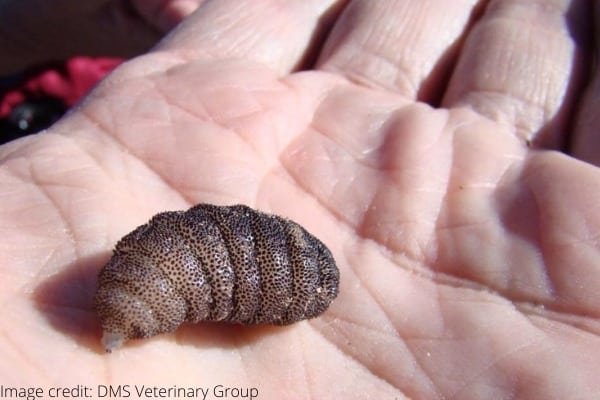
Now, before you get too squeamish, let’s break this down. Think of a wolf worm larva as a butterfly before it finds its wings. It starts off in a very different form—one that might not be as pretty but is just as intriguing. So grab your coffee, and let’s explore the lifecycle of these unique insects in a way that’s both clear and engaging.
What Exactly Are Botflies?
You might be wondering what botflies really are. Botflies are a type of fly that belongs to the family Oestridae. They are known for their parasitic behavior, particularly in mammals. Unlike your typical housefly, botflies have an interesting and somewhat creepy way of growing up.
The term “botfly” usually refers to various species, including the infamous *Dermatobia hominis*. These insects are notorious for laying their eggs on animals, where their larvae will develop. And guess what? Those larvae can be pretty big—up to an inch long during their growth phase! This growth phase happens while they’re living under the skin of their hosts, which is both fascinating and a little alarming.
The Lifecycle of Botflies
Let’s dive into the botfly lifecycle. It doesn’t just involve one simple transition; it’s a multi-stage process that’s truly captivating. Here’s how it typically unfolds:
1. **Egg Stage**: It all begins when a female botfly lays her eggs—often on a mammal’s skin.
2. **Larval Stage**: Once the eggs hatch, the larvae start their “wolf worm” phase, burrowing into the host’s skin.
3. **Pupal Stage**: After feeding and growing, the larvae drop out of their host and form a pupa in the soil.
4. **Adult Stage**: Finally, the adult botfly emerges from the pupa, ready to reproduce and continue the cycle.
So, each stage serves a purpose, ensuring the species thrives. Seriously, nature has its own way of being both brutal and beautiful, right?
From Larvae to Pupae: The Transition Explained
The transition from wolf worm larvae to pupae is quite a crucial moment in a botfly’s life. After living and growing within the host, the larvae prepare for their next big change. So, how does this happen?
When the larvae are ready to transition, they exit the host’s body, often causing some discomfort to the animal. This is where things can get a bit gruesome, but it’s all part of survival. Once they drop out, they dig into the ground and enter the pupal stage.
During this phase, the larvae undergo metamorphosis, where their bodies start to change dramatically—like a caterpillar turning into a butterfly. They stop eating and start to transform internally. It’s a bit like stepping into a cocoon, where they get ready for adult life. This stage can last anywhere from a few weeks to several months, depending on environmental factors.
The Adult Botfly: A New Beginning
Once the transformation is complete, the adult botfly emerges from the pupa. But here’s where it gets even more interesting. Adult botflies don’t have the same lifestyle as their larvae. Instead, they focus on reproduction. Imagine being a tiny, newly-emerged adult that’s ready to find a mate.
Adult botflies have a short lifespan, typically around two to three months. They don’t feed in the traditional sense—instead, they rely on energy reserves built during the larval stage to get through their adult life. Their main goal? To find a host and lay more eggs, thus continuing the cycle. It’s a life focused on survival and reproduction, much like many living things on our planet.
What Makes Botflies Unique?
You might be thinking there are many fascinating insects, so what sets botflies apart? For starters, their lifecycle is one of the most unique among insects. The parasitic nature of their larvae adds a layer of complexity that few other insects can boast.
Moreover, the ability of botfly larvae to grow inside a host makes them a prime example of adaptation. They’ve found a niche that many species would struggle to occupy. But consider this: while they’re thriving, the host animals often experience discomfort or even severe health issues. This relationship raises questions about the balance of nature and the sacrifices made for survival.
Why Should We Care About Botflies?
Now, you might ask why understanding botflies matters. Well, here’s the thing: studying these insects gives us greater insight into ecosystems and the roles various species play. Botflies, while seemingly horrifying, contribute to the balance of nature in their unique way.
Additionally, their lifecycle can help scientists understand parasitism and how it affects host species. This information can be vital in developing methods to manage or protect certain populations, especially in areas where botflies are more common.
The more we learn about the natural world, the better we can appreciate its complexity. Every creature, no matter how strange, plays a part in our ecosystem.
In Conclusion: The Journey of Transformation
The transition from wolf worm larvae to adult botflies is a remarkable journey filled with twists and turns. This lifecycle showcases just how diverse and fascinating nature truly is. From parasitic beginnings to adult life focused on survival, botflies remind us that life’s complexities often lie in unexpected places.
So, the next time you hear someone mention botflies, you can share a piece of this incredible transformation story. After all, understanding the world around us—creepy creatures included—makes us more connected to the environment. And who knows? You might just inspire someone else to look closer at the strange wonders of nature.
